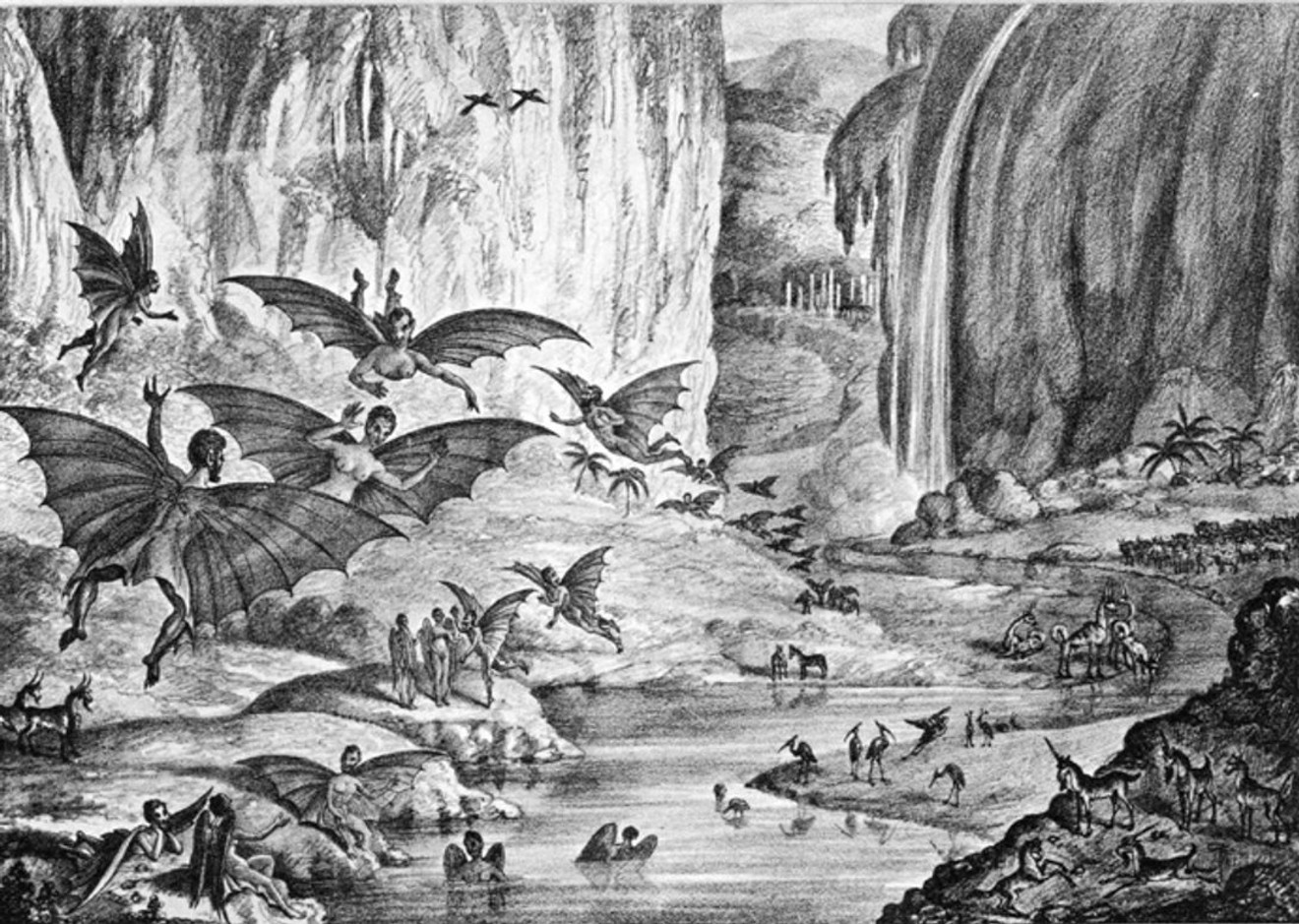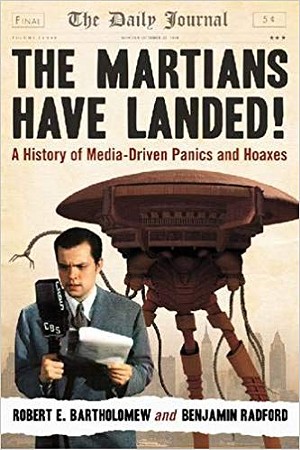The Martians Have Landed! A History of Media-Driven Panics and Hoaxes
By Robert E. Bartholomew and Benjamin Radford
250 pp.
$29.95
McFarland
On the evening of October 30, 1938, an Indiana women burst into her local church in full panic mode. “New York destroyed! It’s the end of the world!” she screamed to a startled congregation. “You might as well go home and die. I heard it on the radio!”
But what the woman heard was not a news report about aliens from another planet who had come to earth to take over the planet and randomly murder the populace. Instead, it was a radio play dramatization of H.G. Wells’ novel The War of the Worlds. She must have missed the short disclaimer at the very top of the program that actor Orson Welles and his troupe had put in there. But gee, it sure sounded like the real thing with a music program interrupted by frequently longer – and more panicked – news reports of the alien invasion…
Welles managed to pull off what is considered the greatest and most famous hoax of the last century – authors Bartholomew and Radford here claim of 6 million total radio listeners, about 1.7 million felt at some point it was real. But it was hardly the first or only for the medium or radio or any other – and sometimes with different results.
When a radio station in Ecuador tried the same thing a little over a decade later, a mob of angry residents rushed the building, burned down the station, and more than a dozen people died in the melee, including the drama’s creator.
And radio is not the only medium represented in this book. In 1835 the newspaper The New York Sun (the publication of Virginia and Santa Claus…) ran a series of articles that purported to tell of what was seen on the surface of the moon through a powerful telescope in South Africa: A lush vegetation, bizarre creatures, and threatening-looking half-men/half-bat creatures.
So convincing were the words of journalist Richard Adams Locke (writing as an astronomer) that competing New York papers scurried to figure out why they were being scooped on the Story of the Century. It was only when Locke admitted to a friend and fellow journalist while they were drinking it was all fiction did the bubble burst. Though even after, Sun editor and co-conspirator Benjamin Day refused to admit the hoax.
Other newspaper-driven hoaxes (in a less media-sophisticated age) warned New Yorkers that animals from the Central Park Zoo had escaped and were on a murderous rampage (1874), that Haley’s Comet would spell doom for the world (1910), and a “mad gasser” was on the loose (1944).
And on the small screen, TV movies like Special Bulletin and Without Warning – made to resemble breaking news reports – made it seem like Americans were being threatened by an asteroid crash or terrorist bent on destroying the country. Though by the time these were shown in the 1980s and 1990s, fewer viewers were taken in.
The book also includes more recent events that owe more to media and public exaggeration than actual hoaxing. Remember the scare about Satanic Day Care owners who were initiating young children into dark and sexual arts, something buoyed by sensationalistic daytime talk shows like “Geraldo” and “Sally Jessy Raphael?”
Or the Bird Flu that was going to kill millions? Or the thousands of children in Japan who supposedly suffered epileptic seizures after watching an episode of the cartoon “Pokeman” that featured flashing lights? Or the kidnapping clowns, "Good Times" computer virus, rampant shark attacks, organ theft rings, and poisoned Halloween candy?
This book was first published in 2011 and is in a new printing, and most stories come in bite-sized chapters. But it’s practically begging for an update – many more chapters could be added with all the thing that have ended in “-Gate” the past decade. Not to mention the rise and prevalence of social media, where anyone with a smart phone could possibly originate a hoax, panic, or social movement. No longer do you have to be a “journalist” to have that power.
“Unprecedented amounts of information cross international boundaries of our global village in the blink of an eye,” the authors write. “As we grow more reliant on the media in our everyday lives, we must also be wary of its potential – be it intentional or unconscious – to transmit erroneous images of the world we live in.”
That’s very true. Maybe the message should be sent out on Twitter. And did you see what this article that my second cousin’s stepdaughter’s aunt forwarded and swears it’s true and it happened to her as well…
Support Us
Houston's independent source of
local news and culture
account
- Welcome,
Insider - Login
- My Account
- My Newsletters
- Contribute
- Contact Us
- Sign out
Run For Your Lives! Something Bad is Coming! I Saw/Read/Heard About It!
Bob Ruggiero September 23, 2019 5:00AM

This 1835 lithograph of flying bat-creatures from the New York Sun purportedly illustrated what a famed astronomer saw on the surface of the moon through a powerful telescope.
Public Domain
[
{
"name": "Related Stories / Support Us Combo",
"component": "11591218",
"insertPoint": "4",
"requiredCountToDisplay": "4"
},{
"name": "Air - Billboard - Inline Content",
"component": "11591214",
"insertPoint": "2/3",
"requiredCountToDisplay": "7"
},{
"name": "R1 - Beta - Mobile Only",
"component": "12287027",
"insertPoint": "8",
"requiredCountToDisplay": "8"
},{
"name": "Air - MediumRectangle - Inline Content - Mobile Display Size 2",
"component": "11591215",
"insertPoint": "12",
"requiredCountToDisplay": "12"
},{
"name": "Air - MediumRectangle - Inline Content - Mobile Display Size 2",
"component": "11591215",
"insertPoint": "4th",
"startingPoint": "16",
"requiredCountToDisplay": "12"
}
,{
"name": "RevContent - In Article",
"component": "12527128",
"insertPoint": "3/5",
"requiredCountToDisplay": "5"
}
]
KEEP THE HOUSTON PRESS FREE...
Since we started the Houston Press, it has been defined as the free, independent voice of Houston, and we'd like to keep it that way. With local media under siege, it's more important than ever for us to rally support behind funding our local journalism. You can help by participating in our "I Support" program, allowing us to keep offering readers access to our incisive coverage of local news, food and culture with no paywalls.
Bob Ruggiero has been writing about music, books, visual arts and entertainment for the Houston Press since 1997, with an emphasis on classic rock. He used to have an incredible and luxurious mullet in college as well. He is the author of the band biography Slippin’ Out of Darkness: The Story of WAR.
Contact:
Bob Ruggiero
Trending Arts & Culture
- Reviews For The Easily Distracted:
Abigail - Houston Bookstore Crawl Celebrates Small Businesses and Literary Diversity
- The 10 Best And Most Controversial Hustler Magazine Covers Ever (NSFW)
-
Sponsored Content From: [%sponsoredBy%]
[%title%]

Don't Miss Out
SIGN UP for the latest
arts & culture
news, free stuff and more!
Become a member to support the independent voice of Houston
and help keep the future of the Houston Press FREE
Use of this website constitutes acceptance of our
terms of use,
our cookies policy, and our
privacy policy
The Houston Press may earn a portion of sales from products & services purchased through links on our site from our
affiliate partners.
©2024
Houston Press, LP. All rights reserved.






